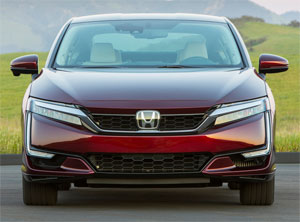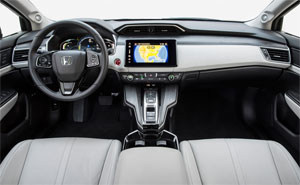2017 Honda Clarity Fuel Cell
With battery powered EV’s now well on their way to being mainstream, you might wonder if hydrogen fuel cell powered electrics are still being pursued. Well, yes they are with Toyota, Hyundai, and now Honda fielding new showroom models. In Honda’s case, it’s the 2017 Honda Clarity Fuel Cell sedan, and it’s sure to make our look down the road ahead a lot clearer.
Back in 2008, we drove Honda’s vision for the hydrogen fuel-cell powered automotive future, the FCX Clarity. And, while everyone knew it was still a work in progress, it impressed us with its easy manners and effortless appeal.
The 2017 Honda Clarity Fuel Cell is clearly an evolution of the FCX; with the biggest improvement being the shrinking of the fuel cell stack itself, now small enough to be placed in the engine bay, along with the electric drive motor.
That leaves just two hydrogen tanks to find space for. A small one is located under the rear seats, while a larger one sits just behind them.
 Output is 174-horsepower and 221 lb-ft. of torque. But best be frugal with it, as unless you live near one of the few hydrogen refueling stations in California, you don’t want to exhaust the still impressive 366-mile range too quickly. For the record, that’s more range than any battery powered EV you can buy today.
Output is 174-horsepower and 221 lb-ft. of torque. But best be frugal with it, as unless you live near one of the few hydrogen refueling stations in California, you don’t want to exhaust the still impressive 366-mile range too quickly. For the record, that’s more range than any battery powered EV you can buy today.
Indeed, Honda claims it’s the longest driving range of any zero-emission vehicle. Plus, fueling doesn’t take hours, but approximately five minutes.
The Clarity comes with Government Fuel Economy MPGe ratings of 69-City, 67-Highway, and 68-Combined.
During our early drive time around Santa Barbara, California; the Clarity Fuel Cell drove mostly like a pure-EV, but with power delivery that feels more linear, more like a traditional combustion powertrain. Likewise, the regen braking is not as aggressive as a battery electric, even when dialed up in sport mode. Yes, there is a sport mode.
And you can definitely detect Clarity’s 4,134–lbs. through corners, but it never feels sloppy. Rather, Honda smooth and mostly quiet, save for a few awkward whirring and air-flow noises you haven’t heard before. Honda claims to have quieted down the drive motor significantly from the FCX Clarity.
 The cabin is quite nice looking; not too futuristic or even that much different from say… a Civic. But things do feel a little tighter inside, mostly because of the wide and protruding center console.
The cabin is quite nice looking; not too futuristic or even that much different from say… a Civic. But things do feel a little tighter inside, mostly because of the wide and protruding center console.
Not so in the rear seats where, with no big battery to hide, there’s plenty of both leg and head room and true 3-across seating.
Even with a hydrogen tank eating up some trunk space, there’s still a good 11.8 cubic-ft. of it.
Safety systems are also typical Honda; including Lane Keeping Assist, and Collision Mitigation braking. There’s even a Head-Up Display and Honda’s LaneWatch side view camera.
Also helping the driver keep track is an innovative Digital Graphic meter; while Apple Car Play and Android Auto are a part of the new 8.0-inch HD touchscreen display audio system.
The exterior may not appear as far into the future as it once did, but it’s clearly not your everyday sedan either.
 Along with the usual LED headlights and daytime runners, the Clarity has a host of air cheating elements such as rear “air curtains”, keeping wind off the wheels, and the world’s first “air curtain ducts” on the rear doors.
Along with the usual LED headlights and daytime runners, the Clarity has a host of air cheating elements such as rear “air curtains”, keeping wind off the wheels, and the world’s first “air curtain ducts” on the rear doors.
Body panels are mostly aluminum. Wheels are 18-inch alloys, wearing Michelin Energy Saver tires.
As for size, its 108.3-inch wheelbase is exactly 2.0-inches longer than a Civic Sedan.
And just in case you don’t live near a hydrogen pump, Honda has announced that a plug-in hybrid, as well as their first pure-EV will soon join the Clarity lineup.
If you could buy the Clarity Fuel Cell, pricing would be $59,365; but for now, Honda is still going with a leasing only plan at $369 a month. Act now, and Honda will even throw in up to $15,000 of free fuel during your 3-year lease.
We know the current market for the 2017 Honda Clarity Fuel Cell is tiny, and only in California. But in a larger sense, we’re not convinced that this wave of the future will ever crash upon our shores, as we are much further along a pure-EV path. But, Honda is not concerned with such trivialities, they’ve got innovating to do, and if we ever do get that “Hydrogen highway”, Honda, and the Clarity Fuel Cell, will be at the head of the lane.
Specifications
- Horsepower: 174
- Torque: 221 lb-ft.
- EPA: 69 MPGe city / 67 MPGe highway,
2024 Toyota Land Cruiser
Toyota’s Go Anywhere Globetrotter Returns To U.S.
Every once in a while, we all need a reset. A time to get back to basics and prioritize the things that really matter. Well, for the Toyota Land Cruiser that time is now. So, let’s find out if that means bigger and better things for Toyota’s iconic off-roader.
The Toyota Land Cruiser’s status among the global off-road community is legendary, and it’s hard to imagine there’s any corner of the earth where a Land Cruiser hasn’t kicked up a little dust or mud. Well, 2024 sees the return of the Land Cruiser to the U.S. market after a 3-year hiatus, getting a major reset for the journey.
The reset comes mostly by no longer being based on the large three-row “300-series” chassis, but a new version of the smaller “200-series,” now known as the J250. As with the latest Tacoma, it uses the Tundra pickup’s full-size steel frame.
While the main Land Cruiser model, which goes by simply Land Cruiser, is packed full of luxury and convenience features, there is also a stripped-down model known as the 1958, honoring the first year the Land Cruiser made landfall here in North America. And it is that 1958 we have here, and we were glad to see it, as it also celebrates the original’s back-to-basics approach as a blank canvas for you to personalize as you tackle more and more adventures.
Not that it’s fully stripped down, as 8-inch touchscreen infotainment, a 7-inch full-color multi-information display, and automatic climate control are still standard. Plus, some seriously durable materials, and great heated cloth front seats that throw off some get serious 1990s Tacoma vibes.
But outside, there’s a definite lack of flashy trim and basic looking 18-inch wheels with Yokohama Geolander all-season tires; plus, big chunky bumpers and tilt-up back glass, which is a rarity that we appreciate. Though there is a little too much plastic in places that are sure to see some abuse if you do any significant off-roading.
It even feels a little rough around the edges, but for us it just adds to the rugged old-school utility vibe in a good way.
We did just that, both here in the Mid-Atlantic as well as in the California desert; and while there are some tech-forward driving aids, the actual hardware is in most cases plenty to get things done. That includes standard full-time dual-range four-wheel-drive, locking center and rear diffs, and 8.7-inches of ground clearance. A front stabilizer bar disconnect is also available to allow for increased articulation.
Who needs a V6 or even a V8 when you’ve got Toyota’s i-FORCE MAX setup at your disposal with 326 horsepower and 465 lb-ft of torque coming from a 2.4-liter turbo-four with an electric motor sandwiched between the engine and its eight-speed automatic transmission. Low speed torque delivery is impressive. It even feels a little rough around the edges, which may be a turn off to some, but for us it just adds to the rugged old-school utility vibe in a good way.
And it certainly feels quicker than an off roader needs to be, with an instant torque dump as soon as we eased on the throttle at our Mason Dixon test track; helping us get to 60 in 8.1 seconds and through the quarter-mile in 16.3 seconds at 86 mph. Considering the Land Cruiser’s terrain conquering mission, it behaved quite well in our handling course; it was plenty responsive to inputs, with less body roll than we expected and plenty of grip from the tires. The steering was light and quick but as expected didn’t provide much feel. Other than significant nosedive, braking performance was exceptional. Only 107-feet to panic stop us from 60 mph.
With the shift to the smaller size, there’s no more third row available, and cargo capacity now comes in at 46.2 cubic-feet with a max of a still healthy 82.1. Now, the best part of the Land Cruiser’s return is the entry price of $57,445. That’s about 30-grand less than what the last Land Cruiser went for back in 2021.
Whether it’s over the top fashion trends, mullets, or zombies; just when you think they’re dead, they come roaring back to life. Of course, we’re much happier to see the resurrection of this 2024 Toyota Land Cruiser than any of those things. Toyota is one brand that still recognizes the value of full-framed rugged rigs and has also acknowledged that sometimes less really is more. The Godfather of Toyota off-roading is back and better than ever.







